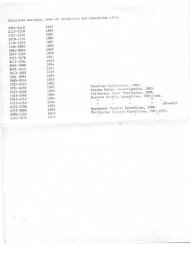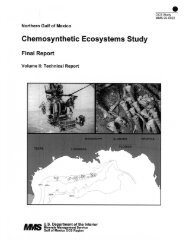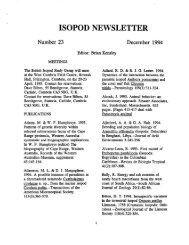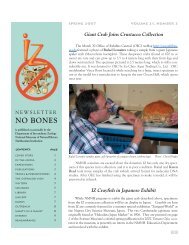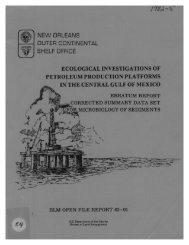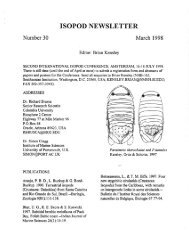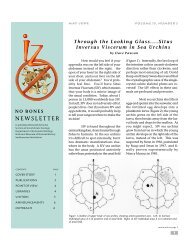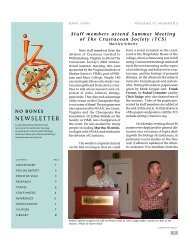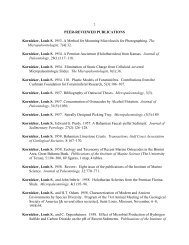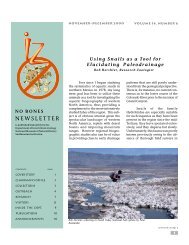Executive Summary - Department of Invertebrate Zoology
Executive Summary - Department of Invertebrate Zoology
Executive Summary - Department of Invertebrate Zoology
You also want an ePaper? Increase the reach of your titles
YUMPU automatically turns print PDFs into web optimized ePapers that Google loves.
~<br />
.i u iiaa .: c i,G :r ~""~' t ^n ( No 11 etnn~<br />
~<br />
Neuston collections were obtained every th .ee hours for a 24-hour<br />
period at each station during each quarterly cruis_ . At stations D1,<br />
N3, and F2 during the second year only a single neuston tow was made,<br />
in conjunction with bongo sampling . The neuston sampler, designed at<br />
Woods Hole Oceanographic Institution, consisted <strong>of</strong> two<br />
hyc+rodynamically-shaped . foam-filled floats connected by an endless<br />
fiberglass belt, accommodating a standard one-meter plankton net and<br />
towed by a four-point bridle . n 505 um mesh net was employed in all<br />
neuston sampling . The unit sampled the surface laver to an<br />
approximate depth (floating depth) <strong>of</strong> 12 cm and a width <strong>of</strong> one meter .<br />
Tows were made from an extended boom in a widely circular track Zo<br />
keep the net away from the ship's wake and, exc- . where abundance <strong>of</strong><br />
salps or ctenophores dictated a shorter tow, we• :` 20 minutes<br />
duration .<br />
Collected samples were washed into buckets, where they were<br />
inspected for tarballs and large, readily identified species .<br />
Tarballs, if present, were removed to labelled plastic zip-bags and<br />
frozen . Large species, if present, were transferred to acid-washed,<br />
teflon-capped jars and frozen for trace metal and hydrocarbon<br />
analysis . A maximum <strong>of</strong> two species was selected at each station, with<br />
specimens accumulated for a given station through the eight neuston<br />
tows at 24-hour stations . Numbers and identity <strong>of</strong> *removed specimens<br />
and the occurrence cf tarballs were noted on collection log sheets .<br />
Sediments<br />
Sediment samples for grain size, organic carbon, and nitrogen<br />
znalyses were collected at each grab station . At each station, 12<br />
replicate 0 .1 m2 Smith-McIntyre grab hauls were s ..ade except at some<br />
deep stations where, because <strong>of</strong> long haul timP, few,~r hauls were made .<br />
Into each <strong>of</strong> these successful grabs, a 3 .5 cu inside diameter clear<br />
acrylic core was inserted, removed, and capped an both ends for grain<br />
size analysis . The cores generally contained the top 10 cm <strong>of</strong><br />
sediment . During the first year, cores from the six grabs taken for<br />
trace metal or hydrocarbon samples, usually the first six, were sent<br />
to the USGS, Woods Hole, where a single grain size analysis was<br />
performed on composited aliquants from the cores and the remaining<br />
material returned to VIMS . At VIMS grain size ana .'vses were performed<br />
on all six sediment samples from the grabs taken :ar faunal analysis<br />
and two <strong>of</strong> the individual samples returned by USGS . During the second<br />
year all twelve sediment samples were analyzed at VIMS .<br />
Organic carbon and nitrogen samples were collected in a similar<br />
fashion but in smaller diameter core tubes (2 .2 cm inside diameter) .<br />
Gue core sanple each was taken from the six grabs collected for<br />
analysas <strong>of</strong> macrobenthos . Samples were quickly frozen and remained so<br />
until analysis .<br />
30



